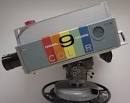 Ry Cooder sings and plays “Tamp ’Em Up Solid” at the Cambridge Folk Festival in 1979:
Ry Cooder sings and plays “Tamp ’Em Up Solid” at the Cambridge Folk Festival in 1979:
(This is the latest in a series of arts-related videos that appear in this space each Monday, Wednesday, and Friday)
Terry Teachout on the arts in New York City
In today’s Wall Street Journal I review an important Chicago-area revival of Company. Here’s an excerpt.
* * *
Sooner or later, every play becomes a history play, a time capsule whose carefully preserved contents show us something of what life was like at a particular moment in the past. Some plays, however, tell us far more than others about such moments. One of them is “Company,” the 1970 musical in which Stephen Sondheim and George Furth described what it was like to be a member of the urban bourgeoisie at the moment when America was becoming a country where marriage for life is not a normal destiny but an increasingly remote possibility. Twenty years ago, I thought that “Company” was a period piece. Today it seems prophetic, a hardheaded comedy about the way we live and love now—and its hardheadedness helps to explain why it doesn’t get done as often as it should.
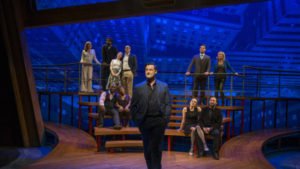 It figures, then, that first-class revivals of “Company” should be thin on the ground. I’ve reviewed only two, on Broadway in 2006 and at Pennsylvania’s Bucks County Playhouse last summer. Now there’s a third: William Brown, one of Chicago’s top directors, has given us a small-scale, contemporary-flavored “Company” (everyone uses cellphones) that is the most dramatically persuasive version I’ve seen to date. It’s the first musical to be mounted on Writers Theatre’s brand-new 250-seat main stage, and it takes full advantage of that handsome space. Indeed, the real “star” of the show is Todd Rosenthal, the set designer. Best known in New York for “August: Osage County,” he has concocted a multi-tiered performing space that shows you how the complex narrative structure of “Company” works. Everything about this production is wholly satisfying, but it’s Mr. Rosenthal’s set that makes the pieces fit together so tightly….
It figures, then, that first-class revivals of “Company” should be thin on the ground. I’ve reviewed only two, on Broadway in 2006 and at Pennsylvania’s Bucks County Playhouse last summer. Now there’s a third: William Brown, one of Chicago’s top directors, has given us a small-scale, contemporary-flavored “Company” (everyone uses cellphones) that is the most dramatically persuasive version I’ve seen to date. It’s the first musical to be mounted on Writers Theatre’s brand-new 250-seat main stage, and it takes full advantage of that handsome space. Indeed, the real “star” of the show is Todd Rosenthal, the set designer. Best known in New York for “August: Osage County,” he has concocted a multi-tiered performing space that shows you how the complex narrative structure of “Company” works. Everything about this production is wholly satisfying, but it’s Mr. Rosenthal’s set that makes the pieces fit together so tightly….
Mr. Brown and Brock Clawson, the choreographer, use this space flexibly but logically, the result being that you know at all times where you are and what you’re seeing. This lets you concentrate on the show itself, and on the acting of the 14-person cast. Everyone keeps it simple—the performances are all rendered in bright primary colors—and Mr. Sondheim’s score is both beautifully sung and played with cool clarity by the seven-piece pit band. Yet there’s no lack of passion…
* * *
Read the whole thing here.
Two excerpts from Writers Theatre’s production of Company:
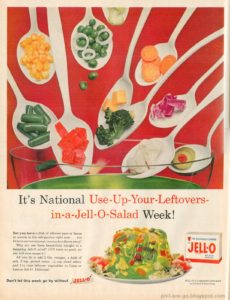 Mrs. T and I dined the other night at a “gastropub” (a neologism I dislike intensely, but we seem to be stuck with it). One of the dishes that I ordered was a salad whose constituent parts included strawberries, dried apricots, goat cheese, lightly salted Marcona almonds, and a raspberry vinaigrette. As I nibbled on an almond, I found myself thinking of the salads of my childhood, which more often than not consisted of dead-tired tomatoes and iceberg lettuce slathered in Thousand Island dressing, and marveled for the umpteenth time at how much America has changed since I was a boy.
Mrs. T and I dined the other night at a “gastropub” (a neologism I dislike intensely, but we seem to be stuck with it). One of the dishes that I ordered was a salad whose constituent parts included strawberries, dried apricots, goat cheese, lightly salted Marcona almonds, and a raspberry vinaigrette. As I nibbled on an almond, I found myself thinking of the salads of my childhood, which more often than not consisted of dead-tired tomatoes and iceberg lettuce slathered in Thousand Island dressing, and marveled for the umpteenth time at how much America has changed since I was a boy.
Having enjoyed a (mostly) happy childhood, I now spend a fair amount of time thinking such thoughts. While I think them with a proper detachment, I can’t help but feel nostalgic for the way things were in the Sixties, the days of the New Frontier. Life really was simpler then, and the choices a small-town boy made each day were both fewer in number and less challenging. Not knowing any better, I was rarely dissatisfied with the alternatives on offer.
Here are a few of them:
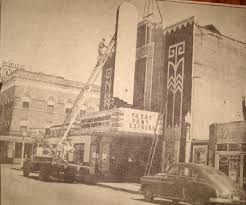 • Smalltown, U.S.A., had two movie theaters, each of which had one screen. The Malone, the respectable one, was where I saw my first movie in 1961. The smaller Rex Theatre showed “dirty” movies, though it flirted with more ambitious fare: it was there that I saw 2001: A Space Odyssey and Franco Zeffirelli’s screen version of Romeo and Juliet. I knew nothing of revival houses until I moved to Kansas City in the mid-Seventies. Until then I’d seen no “old” movies save for The Wizard of Oz, not even the ubiquitous Casablanca. Such films were never shown on KFVS, WPSD, or WSIL, the three stations that we got in Smalltown, and home video had yet to be invented.
• Smalltown, U.S.A., had two movie theaters, each of which had one screen. The Malone, the respectable one, was where I saw my first movie in 1961. The smaller Rex Theatre showed “dirty” movies, though it flirted with more ambitious fare: it was there that I saw 2001: A Space Odyssey and Franco Zeffirelli’s screen version of Romeo and Juliet. I knew nothing of revival houses until I moved to Kansas City in the mid-Seventies. Until then I’d seen no “old” movies save for The Wizard of Oz, not even the ubiquitous Casablanca. Such films were never shown on KFVS, WPSD, or WSIL, the three stations that we got in Smalltown, and home video had yet to be invented.
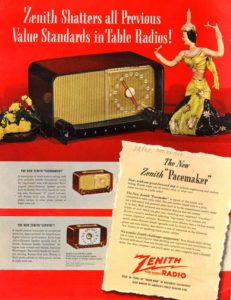 • My mother made breakfast for our family every morning, listening to Paul Harvey News and Comment on a Zenith table-top radio (or was it a Philco?) as she did so. It aired on KSIM, one of only two radio stations that we could pick up in Smalltown. In those days it was an ABC affiliate that played top-40 hits. Now it’s an all-news station on which Rush Limbaugh, the Paul Harvey de nos jours, can be heard in the afternoons. KRHW, Smalltown’s other station, plays country music.
• My mother made breakfast for our family every morning, listening to Paul Harvey News and Comment on a Zenith table-top radio (or was it a Philco?) as she did so. It aired on KSIM, one of only two radio stations that we could pick up in Smalltown. In those days it was an ABC affiliate that played top-40 hits. Now it’s an all-news station on which Rush Limbaugh, the Paul Harvey de nos jours, can be heard in the afternoons. KRHW, Smalltown’s other station, plays country music.
Most of the locals, though, don’t listen to either station anymore, be it in their kitchens or their cars. Like the rest of the world, they’ve largely given up on terrestrial radio, opting instead for CDs or, increasingly, streaming.
• I spread margarine, not butter, on my breakfast toast and dinner rolls. My mother never bought butter at the grocery store. The only time I ever had it was in pre-packaged pat form when we went out to eat, which my family did most Saturday nights. The restaurant I remember best, the Charcoal House, served steaks, pork chops, fried chicken, fried fish, and hamburgers. Three-quarters of the restaurant meals I ate as a boy—probably more—included one of these five entreés. When we had pizza, my mother made it from out of a box. If anybody ever ordered anything else for dinner at a restaurant in my neck of the woods, I can’t recall it. (Possibly spaghetti, but that, too, was a dish more typically eaten at home or school.) Store-bought Chinese food was a rarity reserved for trips to the big city. Otherwise we settled for La Choy in a can, and were glad to get it.
 • The first McDonald’s I ever saw opened in the summer of 1968 in Cape Girardeau, a town located a half-hour north of us. The menu consisted of nine items, five of them beverages. My father sometimes took us there instead of a “real” restaurant. Far from being disappointed, my brother and I thought it a privilege.
• The first McDonald’s I ever saw opened in the summer of 1968 in Cape Girardeau, a town located a half-hour north of us. The menu consisted of nine items, five of them beverages. My father sometimes took us there instead of a “real” restaurant. Far from being disappointed, my brother and I thought it a privilege.
• Coca-Cola came in glass bottles or out of a tap in the Sixties, and there was only one flavor: Diet Coke didn’t come along until 1982. (If you wanted a cherry Coke, you went to a soda fountain.) It was, like our trips to McDonald’s, a special treat, not something a growing boy was permitted to drink every day. Perhaps as a result, I loved it–and still do, truth to tell, though of late I’m more inclined to prefer Polar Seltzer, which suits my mature palate better.
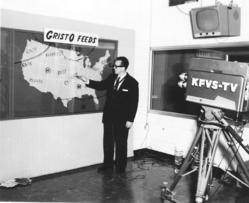 • Since the VCR was as yet a pipe dream, all TV was “appointment” TV in the Sixties. You watched shows when they aired, when they were rerun in the summer, or not at all. We did, however, have two TV sets, a Curtis Mathes cabinet model in the living room and a black-and-white portable in the kitchen (my father was a hardware salesman, so he got a deal on it). This meant I could watch a different show when I wanted to see something in which my parents weren’t interested, so long as it was on CBS or NBC. WSIL, the ABC affiliate, was in Harrisburg, Illinois, a town so far away that the residents of Smalltown could only pick it up with a rooftop antenna. The “rabbit-ear” antennas that stuck up from the back of our portable set wouldn’t do the job, no matter how much you fiddled with them.
• Since the VCR was as yet a pipe dream, all TV was “appointment” TV in the Sixties. You watched shows when they aired, when they were rerun in the summer, or not at all. We did, however, have two TV sets, a Curtis Mathes cabinet model in the living room and a black-and-white portable in the kitchen (my father was a hardware salesman, so he got a deal on it). This meant I could watch a different show when I wanted to see something in which my parents weren’t interested, so long as it was on CBS or NBC. WSIL, the ABC affiliate, was in Harrisburg, Illinois, a town so far away that the residents of Smalltown could only pick it up with a rooftop antenna. The “rabbit-ear” antennas that stuck up from the back of our portable set wouldn’t do the job, no matter how much you fiddled with them.
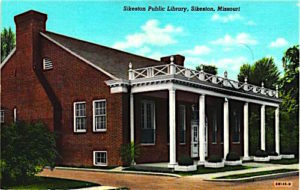 • I went every Saturday afternoon to the Smalltown Public Library, to which I started bicycling as soon as my parents thought me old enough to go by myself. It was a handsome building of modest proportions with a limited number of titles from which to pick the coming week’s leisure-time reading. But it was, along with network TV, my first window on the world beyond Smalltown, and so I reveled in every visit, invariably checking out three books—the maximum allowed—each time I went there. Sometimes I actually propped up a book on the handlebars of my bicycle and started reading it on the way home. This horrified my mother, with good reason. It’s a wonder I didn’t kill myself.
• I went every Saturday afternoon to the Smalltown Public Library, to which I started bicycling as soon as my parents thought me old enough to go by myself. It was a handsome building of modest proportions with a limited number of titles from which to pick the coming week’s leisure-time reading. But it was, along with network TV, my first window on the world beyond Smalltown, and so I reveled in every visit, invariably checking out three books—the maximum allowed—each time I went there. Sometimes I actually propped up a book on the handlebars of my bicycle and started reading it on the way home. This horrified my mother, with good reason. It’s a wonder I didn’t kill myself.
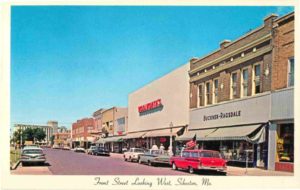 • All of the clothes that I wore as a boy came from two chain stores, Sears and J.C. Penney’s, and two locally owned stores, Buckner-Ragsdale and Falkoff’s (the second of which, I rejoice to report, is still in business). Except for Levi’s and Stetson hats, clothing brands were unheard-of back then, at least in southeast Missouri. I wore what my mother bought, and did so without complaint.
• All of the clothes that I wore as a boy came from two chain stores, Sears and J.C. Penney’s, and two locally owned stores, Buckner-Ragsdale and Falkoff’s (the second of which, I rejoice to report, is still in business). Except for Levi’s and Stetson hats, clothing brands were unheard-of back then, at least in southeast Missouri. I wore what my mother bought, and did so without complaint.
It goes without saying that postmodern America offers its residents, even those who live in places like Smalltown, U.S.A., an overflowing cornucopia of cultural possibilities so wide-ranging that we take for granted the quotidian miracle of what Bruce Springseen too casually dismissed as 57 channels and nothin’ on. Most of these possibilities delight me beyond the wildest dreams of my childhood: I can scarcely imagine life without old movies or downloadable music, and while I could certainly do without Marcona almonds in a pinch, I’m glad to have them as well. Except when I loathe it, I revel in the present.
Strange, then, that to think of such homely things as Coca-Cola in a glass bottle or a shopping trip to Sears should now bring tears to my eyes. I guess that’s what it means to grow old.
UPDATE: Regarding the entrées available in small-town restaurants, a reader writes:
Shrimp (battered and fried). The other thing that was always on the menu, and which I often ordered.
How could I possibly have forgotten fried shrimp?
* * *
A 1958 TV commercial for Imperial margarine:
Mary Chapin Carpenter sings “I Am a Town” on American Music Shop in 1991:
 John T. Scopes is the mystery guest on To Tell the Truth. Scopes was the Tennessee high-school teacher who was the defendant in the 1925 anti-evolution “monkey trial” that was fictionalized in the 1955 play Inherit the Wind. This program was originally telecast by CBS on October 10, 1960. Bud Collyer is the host and the panelists are Tom Poston, Kitty Carlisle, Don Ameche, and Polly Bergen:
John T. Scopes is the mystery guest on To Tell the Truth. Scopes was the Tennessee high-school teacher who was the defendant in the 1925 anti-evolution “monkey trial” that was fictionalized in the 1955 play Inherit the Wind. This program was originally telecast by CBS on October 10, 1960. Bud Collyer is the host and the panelists are Tom Poston, Kitty Carlisle, Don Ameche, and Polly Bergen:
(This is the latest in a series of arts-related videos that appear in this space each Monday, Wednesday, and Friday)
 “It is not because the truth is too difficult to see that we make mistakes. It may even lie on the surface; but we make mistakes because the easiest and most comfortable course for us is to seek insight where it accords with our emotions—especially selfish ones.
“It is not because the truth is too difficult to see that we make mistakes. It may even lie on the surface; but we make mistakes because the easiest and most comfortable course for us is to seek insight where it accords with our emotions—especially selfish ones.
Aleksandr Solzhenitsyn, “Peace and Violence”
In today’s Wall Street Journal “Sightings” column I discuss the Metropolitan Opera’s current travails at the box office, and speculate on whether they’re soluble. Here’s an excerpt.
* * *
The Metropolitan Opera, America’s biggest opera company, sold a lot of tickets last season—660,500, to be exact. But, then, it had no alternative, for it had a lot of tickets to sell. The Metropolitan Opera House is a 3,800-seat monster of an auditorium, vastly bigger than it needs to be. Bayreuth, by contrast, seats 1,925, La Scala 2,030 and the Vienna State Opera 2,200. To keep its doors open, the Met must fill those extra seats, and it’s no longer doing so. Two decades ago, the company earned 90% of its potential box-office revenue. That figure has been declining steadily in recent years and dropped to 66% last season, an all-time low that’s been the talk of the opera world ever since it was disclosed in May. As a result, Peter Gelb, the Met’s general manager, has been forced to hike ticket prices to an average of $158.50 per head. On Broadway, the average price is $103.86.
 So what’s wrong at the Met? Mr. Gelb argued in 2014 that “the question is not whether I think I’m doing a good job or not in trying to keep the [Metropolitan Opera] alive. It’s whether I’m doing a good job or not in the face of a cultural and social rejection of opera as an art form.” He has a point: The National Endowment for the Arts reports that the percentage of U.S. adults who attend at least one operatic performance each year declined to 2.1% in 2012 from 3.2% in 2002. Yet many observers fiercely argue back that the real trouble with the Met is not the culture but Mr. Gelb himself….
So what’s wrong at the Met? Mr. Gelb argued in 2014 that “the question is not whether I think I’m doing a good job or not in trying to keep the [Metropolitan Opera] alive. It’s whether I’m doing a good job or not in the face of a cultural and social rejection of opera as an art form.” He has a point: The National Endowment for the Arts reports that the percentage of U.S. adults who attend at least one operatic performance each year declined to 2.1% in 2012 from 3.2% in 2002. Yet many observers fiercely argue back that the real trouble with the Met is not the culture but Mr. Gelb himself….
You can wrangle on and on about what the Met should do to cut costs and sell more tickets, but you may be wasting your time and breath. For if you know anything at all about economics, you’ve probably already got a pretty good idea of what’s happening there. It sounds like a raging case of cost disease—one that could be fatal.
Cost disease is the term used by economists to describe the condition of a business in which wages go up without a corresponding increase in productivity, not because the workers are lazy but because the business itself is constituted in such a way as to preclude greater productivity….
* * *
Read the whole thing here.
Here’s my list of recommended Broadway, off-Broadway, and out-of-town shows, updated weekly. In all cases, I gave these shows favorable reviews (if sometimes qualifiedly so) in The Wall Street Journal when they opened. For more information, click on the title.
BROADWAY:
• An American in Paris (musical, G, too complex for small children, closes Jan. 1, reviewed here)
• The Color Purple (musical, PG-13, nearly all performances sold out last week, reviewed here)
• Fully Committed (comedy, PG-13, closes July 31, reviewed here)
• Fun Home (serious musical, PG-13, closes Sept. 10, some performances sold out last week, reviewed here)
• Hamilton (musical, PG-13, Broadway transfer of off-Broadway production, all performances sold out last week, reviewed here)
• Matilda (musical, G, closes Jan. 1, virtually all performances sold out last week, reviewed here)
• Les Misérables (musical, G, too long and complicated for young children, closes Sept. 4, most performances sold out last week, reviewed here)
• On Your Feet! (jukebox musical, G, reviewed here)
OFF BROADWAY:
• The Fantasticks (musical, G, suitable for children capable of enjoying a love story, reviewed here)
• Sense & Sensibility (serious romantic comedy, G, remounting of 2014 off-Broadway production, closes Oct. 2, original production reviewed here)
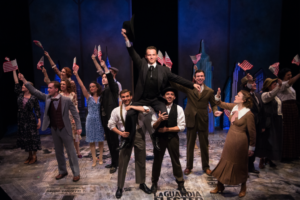 IN STOCKBRIDGE, MASS.:
IN STOCKBRIDGE, MASS.:
• Fiorello! (musical, G, closes July 23, reviewed here)
CLOSING NEXT WEEK ON BROADWAY:
• She Loves Me (musical, G, suitable for bright children capable of enjoying a love story, most performances sold out last week, closes July 10, reviewed here)
CLOSING NEXT WEEK IN CAMBRIDGE, MASS.:
• Twelfth Night (Shakespeare, PG-13, two different stagings of the same play performed by the same cast in rotating repertory, closes July 10, original production reviewed here)
CLOSING NEXT WEEK OFF BROADWAY:
• Confusions (five one-act comedies, PG-13, not suitable for children, Sunday, reviewed here)
• Hero’s Welcome (serious comedy, PG-13, not suitable for children, closes Saturday, reviewed here)
| M | T | W | T | F | S | S |
|---|---|---|---|---|---|---|
| 1 | 2 | 3 | 4 | |||
| 5 | 6 | 7 | 8 | 9 | 10 | 11 |
| 12 | 13 | 14 | 15 | 16 | 17 | 18 |
| 19 | 20 | 21 | 22 | 23 | 24 | 25 |
| 26 | 27 | 28 | 29 | 30 | 31 | |
An ArtsJournal Blog